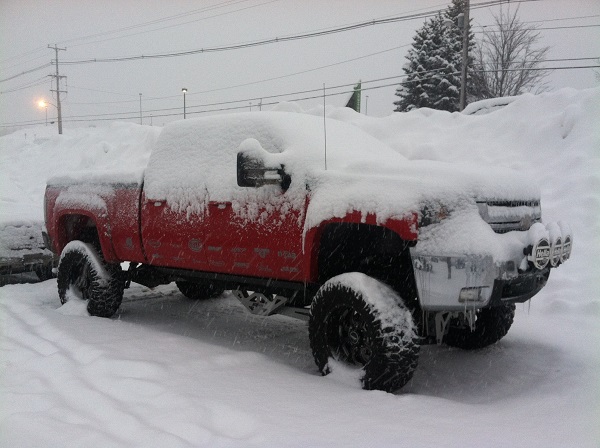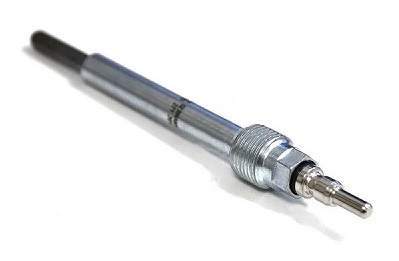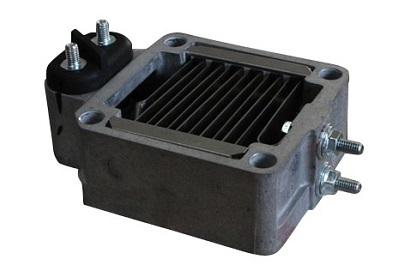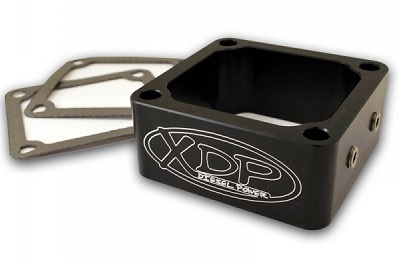
As the weather gets colder diesel engines can become increasingly harder to start. One way vehicle manufacturers deal with this is to incorporate cold starting aids. By installing a heating element, such as glow plugs or a heater grid, a diesel engine can start much easier when the temperatures begin to drop. These heaters not only aid in quicker starts but also help to improve emissions in cold weather.
Different types of heating elements are used to accomplish this task. Ford and GM use the traditional glow plug system in their Powerstroke/Duramax engines. Dodge/Ram instead use a heater grid in their diesel engines. Let’s take a look and compare these two different types of heating elements that are used in diesel trucks.

Glow Plugs
Late-model Ford and GM diesel trucks utilize a glow plug. This long pencil-shaped part has a heating element in the tip and threads directly into the combustion chamber. There is typically one glow plug per cylinder.
The glow plug works by electrifying the heating element, which heats up and emits a glowing light (as the name implies). Intake air is compressed and fuel is sprayed onto the hot tip of the glow plug. When the injected fuel mixes with the compressed air and the hot glow plug, combustion quickly results.
On a cold start (the first startup after the motor has completely cooled down) there is no heat in the chamber which is required to detonate the air and fuel. This is where the glow plug comes in handy, like a spark plug, it typically sits at the top of the cylinder. It heats the air in the combustion chamber so the engine is able to start much quicker in colder temperatures. Unlike a spark plug that works continuously while you drive, a glow plug is only needed during the ignition process and until the engine is warmed up to the normal operating temperature.
Glow Plug Operation
The glow plugs begin to operate when the key is turned to the ‘On’ position. A light on the gauge cluster will illuminate while the glow plugs begin to heat the combustion chambers. When the light goes away, this means you can now turn the key to the start position. The colder the outside temperature, the longer this process can take.

Heater Grids
The Dodge Ram 5.9L/6.7L diesel does not utilize traditional glow plugs like their cross-town rivals. Instead, they use a Heater Grid (or Grid Heater) mounted between the air horn and intake manifold. The heater grid operates on a similar principle as a traditional glow plug system, but with a single heating element. Rather than heating the air in each individual cylinder, the air is heated and then drawn into the cylinders.

Heater Grid/Glow Plug Deletes
Ram 5.9L/6.7L diesel owners looking for simple ways to increase the power in their truck can make use of a heater grid delete. A delete plate replaces the more restrictive factory heater grid with a wide-open passageway for increased airflow. This is typically a straightforward and easy installation, which makes it easy to re-install your heater grid for those colder winter months. Many 5.9L delete plates even come pre-drilled and tapped making life easier if you have plans to add water-methanol injection or nitrous.
Delete kits are also available for engines that use glow plugs. Removing the glow plugs is also strictly for performance/race applications only or if you live in warmer climates.
Signs of a Faulty Glow Plug.
A warning light on the dashboard is often the first clue that you might have a faulty glow plug. Because glow plugs are subjected to extreme temperatures and live in such a harsh environment, they eventually will need to be replaced. The glow plugs on a diesel engine will typically last around 100K miles, but they can fail before then. Here are a few signs to look for that might signal your glow plugs need to be replaced.
1. Hard Starting
If a glow plug has failed an engine can struggle to start. In cold conditions, the combustion chamber may not reach the required temperature to ignite the fuel. If the fuel and battery check out, the glow plugs should be checked next.
2. Black or White Smoke
If the heating element has failed, the effects on the combustion process can sometimes be seen in your rearview mirror. Excess black smoke coming out of the tailpipe in cold weather can be a sign of a possible glow plug failure. It is not uncommon to see white smoke in the winter when your vehicle is warming up. If you see more white smoke than usual, it can be a sign of unburnt fuel which can also lead back to a faulty glow plug. Of course, there are several other issues unrelated to the glow plugs that can cause excess smoke. If you see excess smoke you should your vehicle professionally diagnosed and serviced as soon as possible.
3. Decreased Fuel Economy
This can be another common symptom that might not be as obvious unless you typically keep a close eye on your fuel gauge. When the engine is not properly pre-heated in the winter, it won’t run as efficiently until it is fully warmed up. As a result, your truck can see a decrease in MPG’s (Miles Per Gallon).
4. Rough Idle/Misfire
For ignition to take place it needs to reach at least 450° F. If the combustion chamber does not reach the required temperature a rough idle or misfire can result. The combustion chamber heat typically comes from compression pressure, but additional heat can be required in colder conditions not just for starting, but to run properly until optimal conditions are met. Heater grids can have similar symptoms when they fail. If your Ram starts to experience any issues starting in very cold temperatures then the heater grid should be checked.
Shop the wide selection of Glow Plugs and Heater Grids for your diesel-powered Ford, Chevy/GMC or Dodge Ram at XDP today.
Disclaimer: XDP is in no way affiliated with Cummins or any of its subsidiaries or related companies, and that Cummins has not authorized the sale of any of XDP’s parts, and has not tested or approved any of XDP’s parts for use in genuine Cummins brand products.
